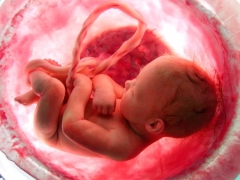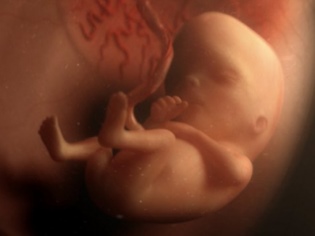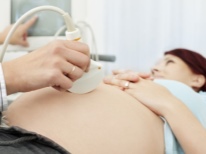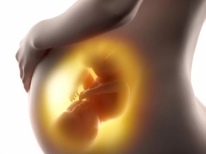How and what does a baby breathe in the womb?
When a child is born, he takes the first breath and screams in pain. For him, this first breath is a big breakthrough in development, a way to a new level. However, it would be wrong to believe that before his birth, a lively and active baby in my mother's tummy does not breathe, because without oxygen he would simply die. If you want to know how and what the baby breathes in the womb, read this article.
About breathing
All people living on the planet during a breath intake air into the lungs. Oxygen remains in the body, and carbon dioxide comes out with the exhalation. This is the simplest description of human gas exchange.
Oxygen is necessary for all human organs and systems (for normal functioning). It is necessary for the brain to support the vital activity of the whole large and complex organism.
No less (and sometimes much more) an unborn child needs oxygen, because in the womb he goes through all the stages of development, clearly illustrating the whole long and complicated path of evolution.
The allegations that the mother during the pregnancy breathes for two is fundamentally wrong. After all, the volume of her lungs practically does not change, and the frequency of inhalations and exhalations remains the same.
A child from the first days of its existence inside the mother breathes independently. Only this is not the usual breaths and exhalations. Such movements are impossible, because there is a child in the aquatic environment, it is surrounded by amniotic fluid from all sides. Its gas exchange occurs through the placenta. For this reason, this method of breathing is called placental.
Placental
The placenta for crumbs is the whole world. She not only allows him to breathe, but also provides food, performs the function of the discharge of waste products of the baby. The placenta protects the baby from mixing its blood with the mother’s blood and the ingress of many harmful substances from it into the children's organism.
The placenta begins to form when the fertilized egg is lowered into the uterine cavity. The place of its attachment to the uterine wall will become the place where the placenta begins to grow.
The umbilical cord, as a connecting link, carries out currents in two directions: oxygen passes from mother to baby, which is in her blood, and carbon dioxide, as well as some other metabolic decomposition products, move in the opposite direction from the baby.
This carbon dioxide (and everything that came from the child) mom exhales the usual mechanical exhalation for her. So mom does not breathe for two, and exhales for two.
Mechanically, this process looks like this. In the umbilical cord there are vessels - a vein and two arteries. Blood is saturated with oxygen through the artery to the baby, and carbon dioxide moves along the vein in the opposite direction.
Threats
It is clear that a woman who herself receives little oxygen, who does not walk much in the open air, smokes during pregnancy, takes alcohol and drugs, works in hazardous production associated with inhalation of toxic substances, gases, gas and smoke, can give her child less oxygen so important to him.
In this case, an unpleasant and dangerous condition such as chronic fetal hypoxia occurs. The baby suffers from oxygen deficiency. At the same time, his body will first compensate for this shortage with all its forces; babies in the mother’s womb have an amazing ability to accumulate oxygen in their tissues in quantities that exceed their immediate needs. So they create for themselves a certain reserve “for a rainy day”.
In addition, when the child lacks oxygen, special hormones begin to be produced, which stabilize his blood pressure and somewhat “slow down” all organs and systems, and the child “switches” to an energy-saving mode.
In this state, unfortunately, the crumb can not live the entire period of stay in my mother's belly.
Compensatory abilities weaken, with prolonged hypoxia, the child’s oxygen supply runs out, and a critical condition sets in, which can lead to intrauterine death, if urgent medical care is not provided to the mother and baby.
The development of oxygen starvation of the baby has a direct impact:
- smoking mom;
- constant severe stress to which a woman is exposed;
- taking certain medications.
The baby, which is without the required amount of oxygen, behaves restlessly at the initial stage of hypoxia. On ultrasound, you can see how the crumb wrinkles with pens, massages the placenta - in an attempt to "get" a little more than the gas that is so necessary for him. If at this stage outside help does not come, the child gradually calms down, his movements become more rare and can stop altogether if the crumb perishes.
That is why it is important to attend a consultation, undergo all examinations prescribed by the midwife, and pass all tests. Indeed, in the event of fetal hypoxia, doctors can provide assistance, in extreme cases, to conduct an emergency caesarean section and save the baby.
Training
Lung tissue in children develops gradually and matures around 35-36 weeks of gestation.
During this period, a special substance is normally produced - a surfactant that will allow the child’s lungs to open up after birth and take that very first breath.
If the crumb is born before 34 weeks, he, as a rule, needs a ventilator and medical support with the same synthesized surfactant.
And also the faith in his strength of doctors, who are fighting for the life of the baby, and parents, who believe in his ability to learn to breathe independently. With the current level of medicine, the mortality rate among such babies was significantly reduced.
Advice pregnant
- Walk and breathe more fresh air. For walks, it is better to choose places where there are few cars and people, where the air is cleaner.
- Drink oxygen cocktails.
- Quit smoking or keep cigarettes to a minimum.
Some doctors quite seriously say that the mother, who smoked for a long time, can harm the baby during pregnancy, abruptly quitting this addiction.
- During this period, she will begin blood pressure surges. and other manifestations of nicotine starvation. They can be very dangerous for the fetus. Therefore, quitting smoking is best before conception.
- From the 20th week of pregnancy, one should carefully consider the daily movements of the child.. This is important in order to determine its condition. Increasing or decreasing movement is sure to be an occasion to schedule an examination for fetal hypoxia.
- At the first signs of hypoxia, you need to trust the doctor, follow the recommendations, take medications prescribed to improve uteroplacental blood flow.
See how the development of the baby in the womb for nine months, see the following video.


























